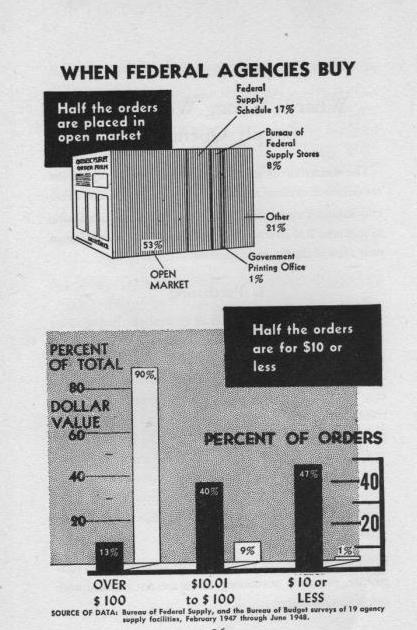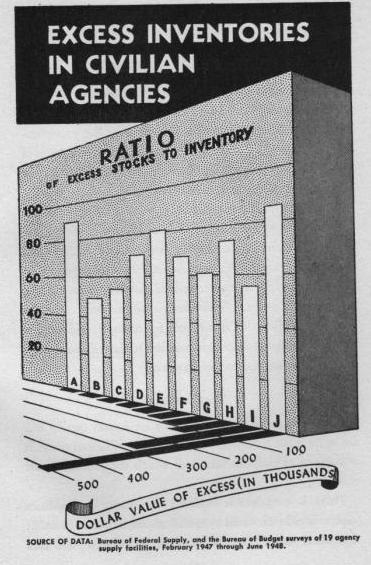What Is Wrong With Federal
Supply Operations
|
The numerous deficiencies in Federal
supply operations are described in detail in the report of the
Commission's Federal Supply Project which has been printed for
distribution as appendix B of its reports. it is sufficient to
point out herein only a few of the major deficiencies:
1. Purchasing One of the major
weaknesses in Federal purchasing stems from the lack of any central
body to coordinate Government purchasing activities. Small
agencies buy for themselves, although the volume of their purchases
does not permit the employment of a competent staff. In common
use items, consolidated orders for several agencies by a single
purchasing office would achieve large savings. The Bureau of
Federal Supply, which was established as the central supply
organization, has insufficient funds to purchase on a centralized
basis. A properly organized central supply service could
almost completely eliminate purchasing offices in the smaller
agencies. a. Purchasing
requires a high degree of professional competence, yet many
purchasing offices are not manned with competent personnel. |
|
|
|
25 |

26
b. Purchasing operations are unplanned.
As evidence of this it is estimated that approximately half of the
several million purchase orders issued annually are for $10
or less. (See chart, When Federal Agencies Buy.)
Since the cost of processing a purchase transaction is greatly in
excess of $10, the overhead cost is more than
the cost of the goods.c.
Purchasing offices lack information and funds necessary to schedule
purchases so as to take maximum advantage of favorable market
conditions.
d. Purchasing officers have
failed to develop cost records and other tools essential to an
effective job of purchasing.
e. Purchasing operations have
degenerated largely into the routine practice of soliciting bids and
awarding contracts to the lowest bidder. An economical job
cannot be expected unless purchasing officials are granted
sufficient latitude to negotiate small purchases, to restrict
competition to reliable vendors, and to give sufficient weight to
quality of the product in awarding contracts.
2. Storage and Issue
It is estimated that over 100,000
employees whose total annual salary rate exceeds 270
million dollars are engaged in storage and issue activities in the
military and civilian agencies.
a. There are too many storage
warehouses. These warehouses maintain duplicating inventories. |
|
|
|
27 |
|
For example, in the Washington
metropolitan area alone there are 72 different
activities of the Government which operate storage and issue
facilities exclusive of the Bureau of Federal Supply and the
Government Printing Office. In the field a similar situation
exists. Six civilian agencies alone show a total of
748 stores facilities at field locations with
inventories in excess of 180 million dollars.
b. A large part of the storage inventories are a
long distance from the point of use so that issuance involves
excessive transportation costs.
It has been estimated that 42 percent of the
Washington stores inventories are for the benefit of field stations.
much of this stock could be delivered by vendors directly to the
field warehouses where they would be readily accessible to the
establishments requiring them. c.
Practically every agency has excessive stocks of supplies.
These agencies are providing space and personnel to handle large
quantities of supplies which, according to present rates of
consumption, will be sufficient to meet their needs for periods of
from 1 to 50 years.
A study of the stock facilities of 10 civilian
agencies by the Office of the Budget showed that excess stocks
averaged 70 percent of the total stock
inventories. (See chart, Excess Inventories in Civilian
Agencies.)
This situation arises from two primary causes, namely (1) most
agencies do not have satisfactory systems of stock control which
permit the replenishment of stock to be related to agency needs, and
(2) most agencies invest appropriation |
|
|
|
28 |

29
|
balances at the end of a fiscal year in supplies
so to avoid returning such funds to the Treasury.
3. Traffic Management Annual
charges paid by the Government for the transportation of property
exceed 1 million dollars which is nearly one-tenth of the revenue of
common carriers for the transportation of property. Government
property and its channels of movement differ materially from the
commercial traffic for which carrier tariffs have been constructed.
Most of the traffic personnel in the Federal Government are
auditing transportation bills. Only a very few employees are
engaged in activities aimed at improving traffic management and
reducing costs. Agencies having well-developed traffic
organizations have demonstrated that substantial savings can be
achieved if attention is devoted to this problem. The
Reconstruction Finance Corporation, for example, effected savings of
17 million dollars on its wartime traffic with
an average annual salary expenditure of $200,000.
4. Specifications If products
purchased are to be of satisfactory quality and are to meet the
specific needs of the Federal Government, it is essential to
establish standards which the products must meet.
There is considerable evidence that many commodities which should
be covered by specifications are not so covered; that many existing
specifications are out of date; and that
|
|
|
|
30 |
|
valid specifications are not being enforced.
Standards are described in terms of the physical characteristics or
composition of the product rather than in terms of performance
required. Much of the responsibility for these conditions
rests upon the individual agencies, but a large part results from
the fact that the machinery for developing and enforcing standard
specifications of Government-wide application has not been
functioning satisfactorily.
Specifications for common-use items are prepared under the Federal
Specifications Board which is composed of the representatives of
11 agencies. Preparation or revision of
a specification has become a very lengthy process, averaging over
2 years, largely because there is insufficient
staff time devoted to this work.
5. Inspection Inspection
is an essential phase of supply, since it is the method of
determining whether the quality of materials or equipment received
meets the requirements stipulated in the specifications or purchase
order.
in the civilian agencies there is no uniformity in quality of
inspection, or in the basic concepts of what types of commodities
should be inspected. Inspection service and testing
laboratories are scattered throughout the country without any
coordination.
In the military agencies, the quality of inspection was found to be
reasonably good, but, in many large cities, each service
|
|
|
|
31 |
|
department maintains a separate inspection
office. There was also found to be a duplication of laboratory
facilities. 6. Property Identification
It is impossible to provide economical management of personal
property if its identity, classification, location, quantity, and
physical characteristics are not known.
The Government agencies do not utilize a standard catalog or other
system of identifying items regularly maintained in stock. in
some agencies each supply point is permitted to devise its own
catalog with the result that one part of an agency may be
overstocked on a given item while another part is making additional
purchases of the same item. There is no uniform system of
cataloging which permits identification and classification of the
materials used by all of the agencies. There have been
17 unrelated systems of property
identification in use at one time. This situation has resulted
in the development of costly duplicating inventories throughout the
Government.
Since the recent war, the national Military Establishment has made
some progress toward a coordinated system of property identification
and the Bureau of Federal Supply is now cooperating in this
endeavor. Nevertheless, a declaration of congressional policy
insisting upon a Federal commodity catalog is necessary to insure
conformity of some of the old-line civilian agencies and to insure
continued military-civilian cooperation.
|
|
|
|
32 |
|
7. Property Utilization
Agencies have devoted far too little attention to effecting needed
economies through maximum use of personal property. Some
agencies maintain no property controls and numerous agencies have
not inventoried their property in years. Other agencies have
costly record systems which are not adapted to assisting management
in obtaining full utilization.
The failure to provide adequate inventory procedures and property
records has resulted in the accumulation of large inventories of
surplus property. By continuing to store such property, these
agencies are building up excess storage and handling costs as well
as permitting the property to depreciate. |
|
|
|
33 |
|
|
